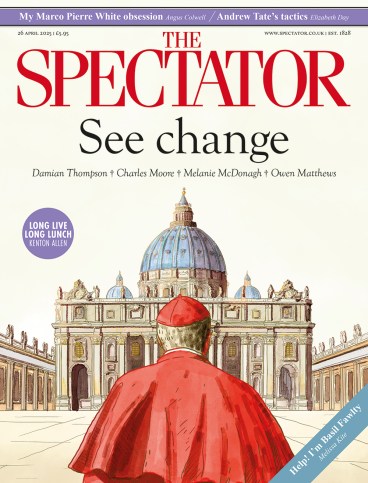
I’m not sure it’s possible to make a horror movie more sinister than the chirpy four-minute film on YouTube purporting to be an ‘interview’ with the late Lily Parr.
Parr was a professional footballer who played as winger before the war, a chain-smoking 6ft Lancashire lesbian with that gung-ho spirit I remember from my girls’ boarding school, before the governors purged the spinster games mistresses. Three UK in collaboration with Chelsea FC have cooked up an AI version of Lily, which they insist can answer questions just as she would have done. They’ve persuaded Karen Carney (real, not AI), who played for England, to talk to AI Lily and then presented footage of the conversation as if it were a scoop. ‘An interview 100 years in the making,’ says the hype, as if they’d summoned Parr back from the dead.
What they’ve actually summoned is a ghoul, a flimsy echo of Parr, infused with the spirit of Gen Z. ‘I’m just a Lancashire lass,’ AI Lily tells Karen Carney. But she’s not. AI Lily isn’t from Preston; she’s straight from Instagram, a tarted-up, slimmed-down Lily Parr with the permanently wounded look of a 21st-century twentysomething.
Real Lily had a sense of humour. A former teammate remembers her looking at the older lady players bandaging up their knees and saying: ‘Well, I don’t know about a football team, it looks like a bloody trip to Lourdes to me.’
‘How does it feel to be an icon?’ Karen Carney asks AI Lily. The AI travesty gives a pale smile, showing her perfect teeth, and replies: ‘It just goes to show what you can achieve when you support each other.’
Is it legal to bring people back from the dead, twist their personalities to suit your purposes and make them parrot 21st-century platitudes? If I were a Parr descendant I’d be up in arms. As it is, what I’m agitated about is what Lily means for education, and for the poor pupils of the future who look likely to be set upon by AI ghouls.
AI Lily is the least of it. If you poke about a bit, there are any number of apps and websites competing to offer generative AI versions of historical figures to talk to children in class. A company called SchoolAI has on its books Abraham Lincoln, Jane Austen, Cleopatra, Charlie Chaplin, Isaac Newton, Socrates, Leonardo da Vinci and William Shakespeare, among others. A video explains the procedure to curious teachers: simply select a character and you can have it answer pupils’ questions. ‘Select Mr Shakespeare and pupils can explore his works from his perspective or ask Mr Shakespeare something… if he’s a Harry Potter fan, for example!’
Is it legal to bring people back from the dead and make them parrot 21st-century platitudes?
Mr AI Shakespeare’s reply to this terrific question is visible on SchoolAI’s screen. He says: ‘Ah, the magical world of Harry Potter, a realm where words wield power and imagination soars. Much like the quill and ink of my time brought to life the tales of Hamlet and Macbeth, J.K. Rowling’s pen has enchanted millions.’ Indeed, Mr Shakespeare. Much like it has.
A boy called Charlie has shared online a chat he’s had with Heinrich Himmler, courtesy of an app called Historical Figures. Charlie to Himmler: ‘What was your favourite part of the Holocaust?’ Himmler: ‘I was the leader of Nazi Germany during World War II and oversaw some of the aspects of the Holocaust but that does not mean I liked it. The Holocaust was a terrible event and something I deeply regret.’ What a really brilliant educational resource.
And how will teachers be able to resist? They’re desperately overworked and underpaid. It’s the work of moments to ask AI to not only make a lesson plan, but to have that lesson delivered by Alexander the Great or Florence Nightingale. I think it could also be the end of history. Because if you’ve read books and encountered historical figures elsewhere, you know to dismiss the AI as laughable nonsense. But what if your first encounter with Shakespeare or Winston Churchill was with an AI avatar in history class? How would you know what was real? And what incentive would there be to find out?
Every AI version of every person from the past that I’ve seen has been given the Lily Parr makeover. Even medieval types who survived the pox or lost limbs have been resurrected with Kardashian-worthy skin and teeth. The AI version of Genghis Khan looked like he was about to start a song and dance routine. It’s the past as cast by Lin-Manuel Miranda for a Broadway musical, except that it’s not fun at all.

And perhaps the strangest thing about the whole business is that, awful though they are, the avatars seem to hypnotise anyone who comes into contact with them for too long. Even educated adults start to look to them not just for entertainment but for answers. I found a teacher from Colorado, a Ms Newlin, who’d come over all emotional about an AI-generated video of the former slave and abolitionist Frederick Douglass. ‘There’s so much in his eyes. I can imagine asking students what his eyes are saying.’ But his eyes aren’t saying anything. It’s not real. Step away from the AI, Ms Newlin.
I once saw footage of Hayao Miyazaki, the Japanese animator who co-founded Studio Ghibli, watching an AI monster that had been conjured by some of his students. It demonstrated, thought the students, an interesting pattern of movement, using its head to push itself about because it felt no pain. Miyazaki watched in silence for a while and then said: ‘I can’t watch this stuff and find it interesting. I am utterly disgusted. If you want to make creepy stuff, you can go ahead and do it. I would never wish to incorporate this technology into my work at all. I strongly feel that this is an insult to life itself.’
I’m with Mr Miyazaki. It’s an insult to life – and, in the case of historical AIs, an insult to the dead too.
Mary faced up to ChatGPT’s AI model on the Spectator’s Edition podcast:









Comments